Computing the Affective-Aesthetic Potential of Literary Texts
Abstract
:1. Introduction
2. SentiArt
- Selection and evaluation of an appropriate VSM, e.g., one can use the procedure described on the fasttext homepage (https://fasttext.cc/docs/en/pretrained-vectors.html) to directly download the (German) VSM called ‘wiki.de.vec’ providing 300d sublexical vectors for each of >2 million words (e.g., in the original uncleaned version [41]).
- Computation of AAP and evaluation of predictive accuracy, i.e. cross-validation with empirical data (e.g., human ratings)
2.1. The Present Study
2.2. VSM Evaluation
2.3. Label List Evaluation Predicting Human Valence Rating Data
2.4. Evaluation of the AAP Construct Predicting Human Liking Ratings
2.5. Predicting Emotional States Over (Narrative) Time
- Model A: All words, i.e., the AAP value for a text segment corresponded to the mean of the AAP values for all unique words (types) in the segment (which also occur in the Subtlex), including function words (N = 4723; mean R2 adj = 0.21).
- Model L: All lemmata (N = 4685; mean R2 adj = 0.18).
- Model C: All content words (N = 3080; mean R2 adj = 0.21).
- Model CL: All content lemmata (N = 3044; mean R2 adj = 0.16).
3. Summary, Discussion, Limitations and Outlook
Author Contributions
Funding
Conflicts of Interest
References
- Hogan, P.C. Affective Narratology: The Emotional Structure of Stories; The University of Nebraska Press: Lincoln, NE, USA, 2011. [Google Scholar]
- Schrott, R.; Jacobs, A.M. Gehirn und Gedicht: Wie wir Unsere Wirklichkeiten Konstruieren (Brain and Poetry: How we Construct our Realities); Hanser: München, Germany, 2011. [Google Scholar]
- Jacobs, A.M.; Hofmann, M.J.; Kinder, A. On Elementary Affective Decisions: To Like Or Not to Like, That Is the Question. Front. Psychol. 2016, 7, 1836. [Google Scholar] [CrossRef] [PubMed] [Green Version]
- Lebrecht, S.; Bar, M.; Barrett, L.F.; Tarr, M.J. Micro-valences: Perceiving affective valence in everyday objects. Front. Psychol. 2012, 3, 107. [Google Scholar] [CrossRef] [PubMed] [Green Version]
- Hutto, C.J.; Gilbert, E.E. VADER: A parsimonious rule-based model for sentiment analysis of social media rext. In Proceedings of the Eighth International Conference on Weblogs and Social Media (ICWSM-14), Ann Arbor, MI, USA, 4 June 2014. [Google Scholar]
- Aryani, A.; Jacobs, A.M.; Conrad, M. Extracting salient sublexical units from written texts: ‘‘Emophon,’’ a corpus-based approach to phonological iconicity. Front. Psychol. 2013, 4, 654. [Google Scholar] [CrossRef] [PubMed] [Green Version]
- Aryani, A.; Kraxenberger, M.; Ullrich, S.; Jacobs, A.M.; Conrad, M. Measuring the basic affective tone of poems via phonological saliency and iconicity. Psychol. Aesthet. Creat. Arts 2016, 10, 191–204. [Google Scholar] [CrossRef] [Green Version]
- Bestgen, Y. Can emotional valence in stories be determined from words? Cognit. Emot. 1994, 8, 21–36. [Google Scholar] [CrossRef]
- Dodds, P.S.; Clark, E.M.; Desu, S.; Frank, M.R.; Reagan, A.J.; Williams, J.R.; Mitchell, L.; Harris, K.D.; Kloumann, I.M.; Bagrow, J.P.; et al. Human language reveals a universal positivity bias. Proc. Natl. Acad. Sci. USA 2015, 112, 2389–2394. [Google Scholar] [CrossRef] [Green Version]
- Jacobs, A.M. Neurocognitive poetics: Methods and models for investigating the neuronal and cognitive-affective bases of literature reception. Front. Hum. Neurosci. 2015, 9, 186. [Google Scholar] [CrossRef] [Green Version]
- Jacobs, A.M. The Gutenberg English Poetry Corpus: Exemplary Quantitative Narrative Analyses. Front. Digit. Humanit. 2018, 5, 5. [Google Scholar] [CrossRef] [Green Version]
- Jacobs, A.M. (Neuro-)Cognitive Poetics and Computational Stylistics. Sci. Study Lit. 2018, 8, 164–207. [Google Scholar] [CrossRef]
- Jacobs, A.M. Sentiment Analysis for Words and Fiction Characters from the Perspective of Computational (Neuro-)Poetics. Front. Robot. AI 2019, 6, 53. [Google Scholar] [CrossRef] [Green Version]
- Jacobs, A.M.; Lüdtke, J. Immersion into narrative and poetic worlds: A neurocognitive poetics perspective. In Handbook of Narrative Absorption; Kuijpers, M., Hakemulder, F., Eds.; John Benjamins: Amsterdam, The Netherlands, 2017; pp. 69–96. [Google Scholar]
- Jockers, M. Introduction to the Syuzhet Package. Available online: https://cran.r- project.org/web/packages/syuzhet/vignettes/syuzhet-vignette.html (accessed on 15 December 2019).
- Klinger, R. Digitale Modellierung von Figurenkomplexität am Beispiel des Parzival von Wolfram von Eschenbach. Available online: http://www.ims.uni- stuttgart.de/institut/mitarbeiter/klingern (accessed on 15 December 2019).
- Klinger, R.; Suliya, S.S.; Reiter, N. Automatic Emotion Detection for Quantitative Literary Studies. A case study based on Franz Kafka’s “Das Schloss” and “Amerika”. In Proceedings of the Digital Humanities 2016: Conference Abstracts, 2016; Jagiellonian University & Pedagogical University: Kraków, Poland, 2016; Available online: http://www.romanklinger.de/publications/klinger-samat-reiter2016.pdf (accessed on 15 December 2019).
- Kim, E.; Padó, S.; Klinger, R. Investigating the relationship between literary genres and emotional plot development. In Proceedings of the Joint SIGHUM Workshop on Computational Linguistics for Cultural Heritage, Social Sciences, Humanities and Literature, Vancouver, BC, Canada, 17–26 August 2017. [Google Scholar]
- Kim, E.; Padó, S.; Klinger, R. Prototypical emotion developments in adventures, romances, and mystery stories. In Digital Humanities; MIT Press: Cambridge, MA, USA, 2017. [Google Scholar]
- Kim, E.; Klinger, R. A survey on sentiment and emotion analysis for computation literary studies. arXiv 2018, arXiv:1808.03137v1. [Google Scholar]
- Whissell, C. Phonosymbolism and the emotional nature of sounds: Evidence of the preferential use of particular phonemes in texts of differing emotional tone. Percept. Mot. Skills 1999, 89, 19–48. [Google Scholar] [CrossRef] [PubMed]
- Whissell, C.; Fournier, M.; Pelland, R.; Weir, D.; Makarec, K. A dictionary of affect in language: IV. Reliability, validity, and applications. Percept. Mot. Skills 1986, 62, 875–888. [Google Scholar] [CrossRef]
- Jacobs, A.M. Towards a neurocognitive poetics model of literary reading. In Towards a Cognitive Neuroscience of Natural Language Use; Willems, R., Ed.; Cambridge University Press: Cambridge, UK, 2015; pp. 135–159. [Google Scholar]
- Miller, G.A. Wörter: Streifzüge durch die Psycholinguistik; Zweitausendeins: Frankfurt, Germany, 1993. [Google Scholar]
- Bühler, K. Sprachtheorie (Language Theory); (Reprint, Stuttgart: Lucius und Lucius); G. Fischer: Stuttgart, Germany, 1934. [Google Scholar]
- Freud, S. Zur Auffassung der Aphasien: Eine kritische Studie [On Aphasia: A Critical Study]; Deuticke: Wien, Austria, 1891. [Google Scholar]
- Jacobs, A.M.; Võ, M.L.-H.; Briesemeister, B.B.; Conrad, M.; Hofmann, M.J.; Kuchinke, L.; Lüdtke, J.; Braun, M. 10 years of BAWLing into affective and aesthetic processes in reading: What are the echoes? Front. Psychol. 2015, 6, 714. [Google Scholar] [CrossRef]
- Ziegler, J.; Montant, M.; Briesemeister, B.; Brink, T.; Wicker, B.; Ponz, A.; Bonnard, M.; Jacobs, A.M.; Braun, M. Do words stink? Neural re-use as a principle for understanding emotions in reading. J. Cognit. Neurosci. 2018, 30, 1023–1032. [Google Scholar] [CrossRef] [Green Version]
- Hu, M.; Liu, B. Mining and summarizing customer reviews. In Proceedings of the Tenth ACM SIGKDD International Conference on Knowledge Discovery and Data Mining, Seattle, WA, USA, 22–25 August 2004; Kim, W., Kohavi, R., Eds.; ACM Press: Washington, DC, USA, 2004; pp. 168–177. [Google Scholar] [CrossRef] [Green Version]
- Wiebe, J.; Wilson, T.; Cardie, C. Annotating Expressions of Opinions and Emotions in Language. Lang. Resour. Eval. 2005, 39, 165–210. [Google Scholar] [CrossRef]
- Turney, P.D. Mining the Web for synonyms: PMI-IR versus LSA on TOEFL. In Proceedings of the 12th European Conference on Machine Learning, Freiburg, Germany, 5–7 September 2001; Springer: Berlin, Germany, 2001; pp. 491–502. [Google Scholar]
- Turney, P.D.; Littman, M.L. Measuring praise and criticism: Inference of semantic orientation from association. ACM Trans. Inf. Syst. (TOIS) 2003, 21, 315–346. [Google Scholar] [CrossRef] [Green Version]
- Schmidtke, D.S.; Schröder, T.; Jacobs, A.M.; Conrad, M. ANGST: Affective norms for German sentiment terms, derived from the affective norms for English words. Behav. Res. Methods 2014, 46, 1108–1118. [Google Scholar] [CrossRef]
- Conrad, M.; Recio, G.; Jacobs, A.M. The time course of emotion effects in first and second language processing: Across cultural ERP study with German-Spanish bilinguals. Front. Psychol. 2011, 2, 1–16. [Google Scholar] [CrossRef] [Green Version]
- Hsu, C.-T.; Jacobs, A.M.; Conrad, M. Can Harry Potter still put a spell on us in a second language? An fMRI study on reading emotion-laden literature in late bilinguals. Cortex 2015, 63, 282–295. [Google Scholar] [CrossRef]
- Veltkamp, G.M.; Recio, G.; Jacobs, A.M.; Conrad, M. Is personality modulated by language? Int. J. Biling. 2013, 17, 496–504. [Google Scholar] [CrossRef]
- Hofmann, M.J.; Biemann, C.; Westbury, C.; Murusidze, M.; Conrad, M.; Jacobs, A.M. Simple Co-Occurrence Statistics Reproducibly Predict Association Ratings. Cognit. Sci. 2018, 1–26. [Google Scholar] [CrossRef] [PubMed] [Green Version]
- Westbury, C. Pay no attention to that man behind the curtain. Ment. Lex. 2016, 11, 350–374. [Google Scholar] [CrossRef]
- Jacobs, A.M.; Schuster, S.; Xue, S.; Lüdtke, J. What’s in the brain that ink may character …: A Quantitative Narrative Analysis of Shakespeare’s 154 Sonnets for Use in Neurocognitive Poetics. Sci. Study Lit. 2017, 7, 4–51. [Google Scholar] [CrossRef]
- Xue, S.; Lüdtke, J.; Sylvester, T.; Jacobs, A.M. Reading Shakespeare Sonnets: Combining Quantitative Narrative Analysis and Predictive Modeling—An Eye Tracking Study. J. Eye Mov. Res. 2019, 12. [Google Scholar] [CrossRef]
- Bojanowski, P.; Grave, E.; Joulin, A.; Mikolov, T. Enriching word vectors with subword information. Trans. Assoc. Comput. Linguist. 2017, 5, 135–146. [Google Scholar] [CrossRef] [Green Version]
- Westbury, C.; Keith, J.; Briesemeister, B.B.; Hofmann, M.J.; Jacobs, A.M. Avoid violence, rioting, and outrage; approach celebration, delight, and strength: Using large text corpora to compute valence, arousal, and the basic emotions. Q. J. Exp. Psychol. 2015, 68, 1599–1622. [Google Scholar] [CrossRef]
- Mikolov, T.; Chen, K.; Corrado, G.; Dean, J. Efficient Estimation of Word Representations in Vector Space. Available online: https://arxiv.org/abs/1301.3781 (accessed on 15 December 2019).
- Brysbaert, M.; Buchmeier, M.; Conrad, M.; Jacobs, A.M.; Bölte, J.; Böhl, A. The word frequency effect: A review of recent developments and implications for the choice of frequency estimates in German. Exp. Psychol. 2011, 58, 412–424. [Google Scholar] [CrossRef]
- Van der Maaten, L.J.P.; Hinton, G.E. Visualizing data using t-SNE. J. Mach. Learn. Res. 2008, 9, 2431–2456. [Google Scholar]
- Võ, M.L.H.; Jacobs, A.M.; Conrad, M. Cross-validating the Berlin affective word list. Behav. Res. Methods 2006, 38, 606–609. [Google Scholar] [CrossRef]
- Võ, M.L.H.; Conrad, M.; Kuchinke, L.; Hartfeld, K.; Hofmann, M.J.; Jacobs, A.M. The Berlin Affective Word List reloaded (BAWL-R). Behav. Res. Methods 2009, 41, 534–539. [Google Scholar] [CrossRef] [PubMed]
- Baroni, M.; Bernardini, S.; Ferraresi, A.; Zanchetta, E. The WaCky Wide Web: A Collection of Very Large Linguistically Processed Web-Crawled Corpora. Lang. Resour. Eval. 2009, 43, 209–226. [Google Scholar] [CrossRef]
- Jacobs, A.M. Quantifying the Beauty of Words: A Neurocognitive Poetics Perspective. Front. Hum. Neurosci. 2017, 11, 622. [Google Scholar] [CrossRef] [PubMed] [Green Version]
- Jacobs, A.M.; Kinder, A. The brain is the prisoner of thought: A machine-learning assisted quantitative narrative analysis of literary metaphors for use in Neurocognitive Poetics. Metaphor Symb. 2017, 32, 139–160. [Google Scholar] [CrossRef]
- Jacobs, A.M.; Kinder, A. What makes a metaphor literary? Answers from two computational studies. Metaphor Symb. 2018, 33, 85–100. [Google Scholar] [CrossRef]
- Jacobs, A.M.; Kinder, A. Features of word similarity. arXiv 2018, arXiv:1808.07999. [Google Scholar]
- Marelli, M.; Baroni, M. Affixation in semantic space: Modeling morpheme meanings with compositional distributional semantics. Psychol. Rev. 2015, 122, 485–515. [Google Scholar] [CrossRef] [Green Version]
- Ekman, P. Basic emotions. In Handbook of Cognition and Emotion; Dalgleish, T., Power, M., Eds.; John Wiley and Sons: Chichester, UK, 1999; pp. 45–60. [Google Scholar]
- Warriner, A.B.; Kuperman, V.; Brysbaert, M. Norms of valence, arousal, and dominance for 13,915 English lemmas. Behav. Res. Methods 2013, 45, 1191–1207. [Google Scholar] [CrossRef] [Green Version]
- Andrews, M.; Vigliocco, G.; Vinson, D. Integrating experien- tial and distributional data to learn semantic representations. Psychol. Rev. 2009, 116, 463–498. [Google Scholar] [CrossRef] [Green Version]
- Lehne, M.; Engel, P.; Rohrmeier, M.; Menninghaus, W.; Jacobs, A.M.; Koelsch, S. Reading a suspenseful literary text activates brain areas related to social cognition and predictive inference. PLoS ONE 2015, 10, e0124550. [Google Scholar] [CrossRef] [Green Version]
- Remus, R.; Quasthoff, U.; Heyer, G. SentiWS—A Publicly Available German-language Resource for Sentiment Analysis. In Proceedings of the 7th International Language Ressources and Evaluation (LREC’10), Valletta, Malta, 17–23 May 2010; pp. 1168–1171. [Google Scholar]
- Rowling, J.K. Harry Potter and the Philosopher’s Stone; Bloomsbury: London, UK, 1997. [Google Scholar]
- Reagan, A.J.; Mitchell, L.; Kiley, D.; Danforth, C.D.; Dodds, P.S. The emotional arcs of stories are dominated by six basic shapes. EPJ Data Sci. 2016, 5, 31. [Google Scholar] [CrossRef] [Green Version]
- Wallentin, M.; Nielsen, A.H.; Vuust, P.; Dohn, A.; Roepstorff, A.; Lund, T.E. Amygdala and heart rate variability responses from listening to emotionally intense parts of a story. Neuroimage 2011, 58, 963–973. [Google Scholar] [CrossRef] [PubMed] [Green Version]
- Liu, B. Sentiment Analysis: Mining Opinions, Sentiments, and Emotions; Cambridge University Press: Cambridge, UK, 2015. [Google Scholar]
- Ullrich, S.; Aryani, A.; Kraxenberger, M.; Jacobs, A.M.; Conrad, M. On the relation between the general affective meaning and the basic sublexical, lexical, and interlexical features of poetic texts—A case study using 57 poems of H. M. Enzensberger. Front. Psychol. 2017, 7, 2073. [Google Scholar] [CrossRef] [PubMed] [Green Version]
- Mulcahy, M.; Gouldthorp, B. Positioning the reader: The effect of narrative point-of-view and familiarity of experience on situation model construction. Lang. Cognit. 2016, 96–123. [Google Scholar] [CrossRef]
- Joffily, M.; Coricelli, G. Emotional valence and the free-energy principle. PLoS Comput. Biol. 2013, 9, e1003094. [Google Scholar] [CrossRef] [Green Version]
- Hsu, C.T.; Jacobs, A.M.; Citron, F.; Conrad, M. The emotion potential of words and passages in reading Harry Potter—An fMRI study. Brain Lang. 2015, 142, 96–114. [Google Scholar] [CrossRef] [Green Version]
- van Krieken, K.; Hoeken, H.; Sanders, J. Evoking and Measuring Identification with Narrative Characters—A Linguistic Cues Framework. Front. Psychol. 2017, 8. [Google Scholar] [CrossRef] [Green Version]
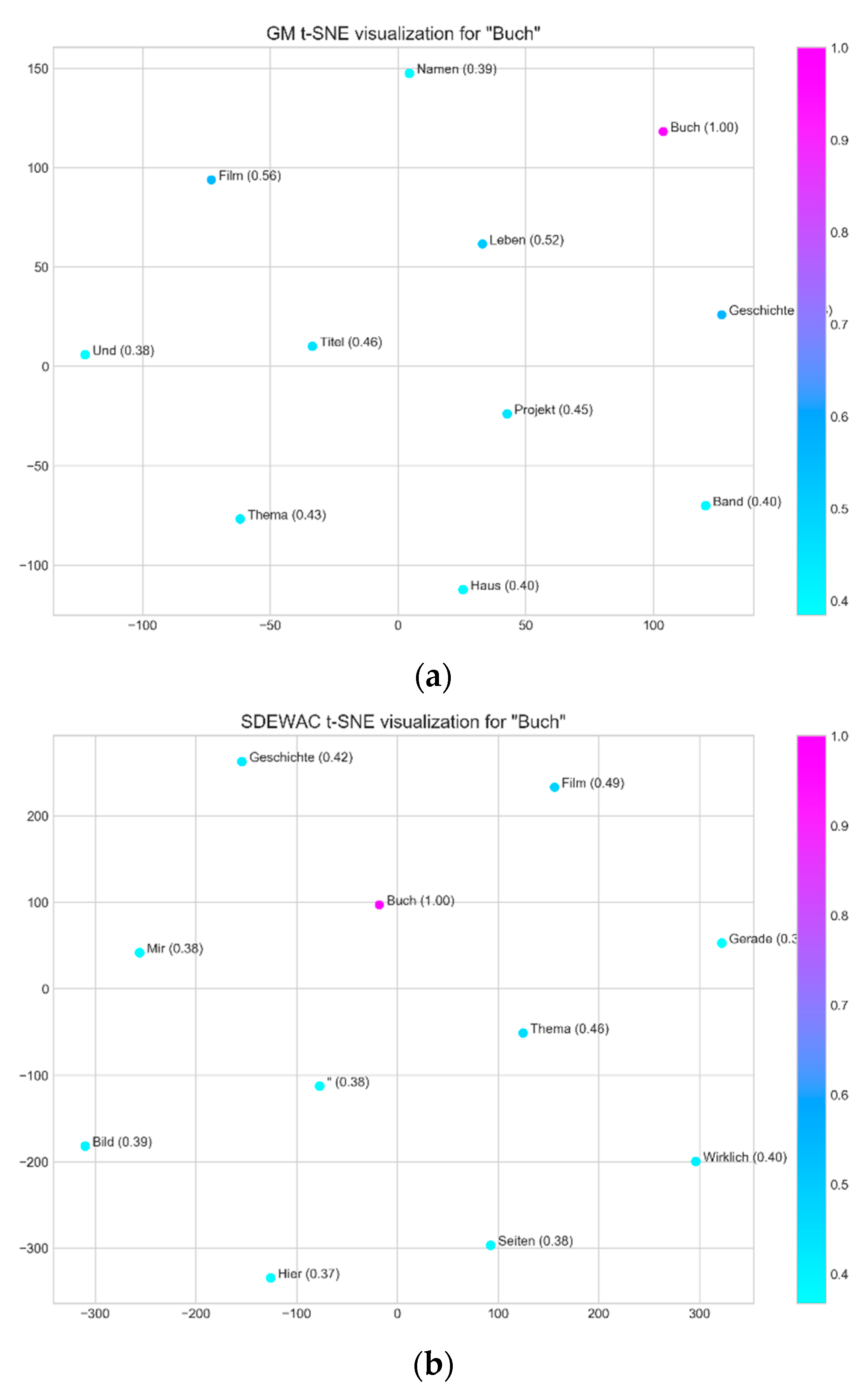
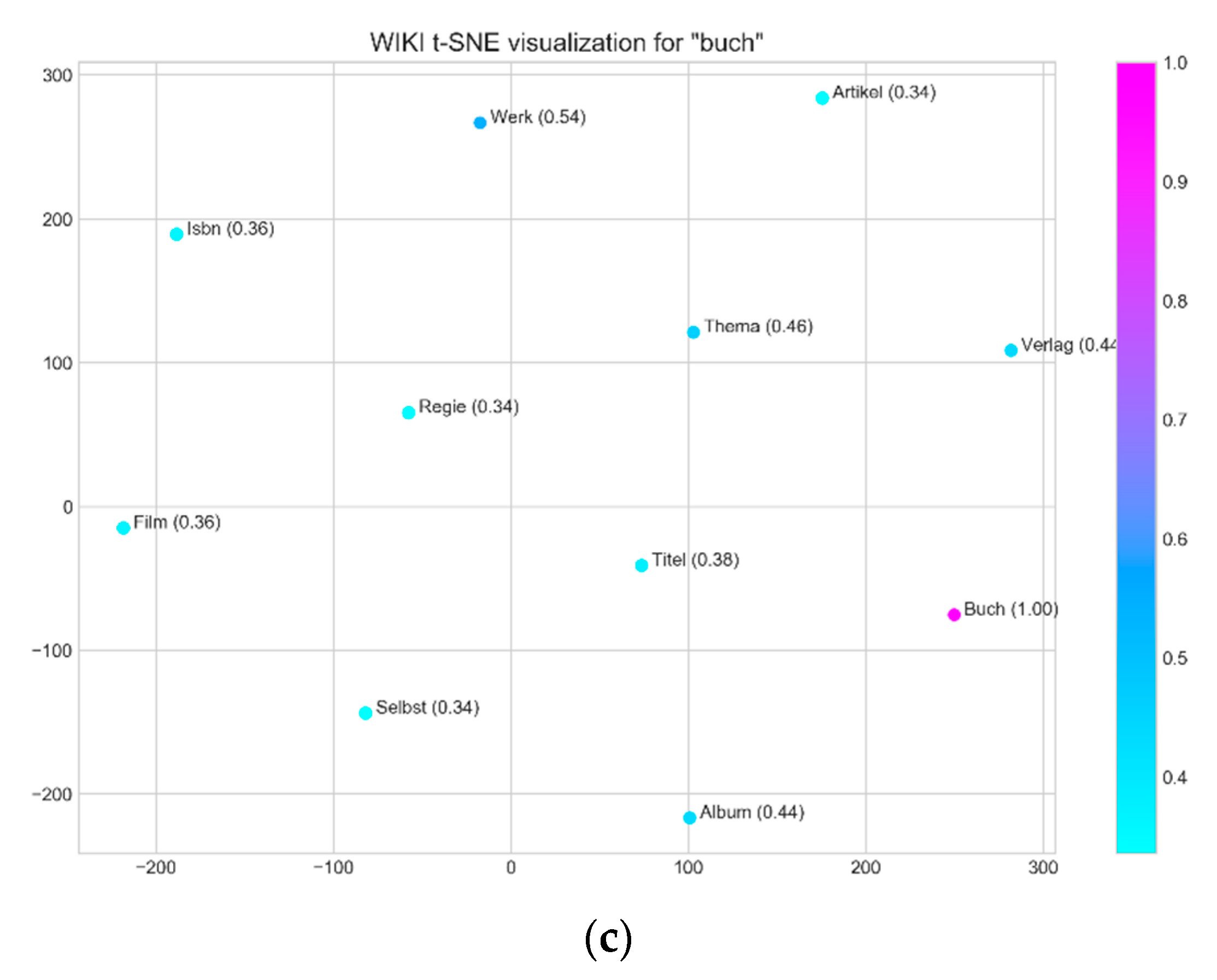
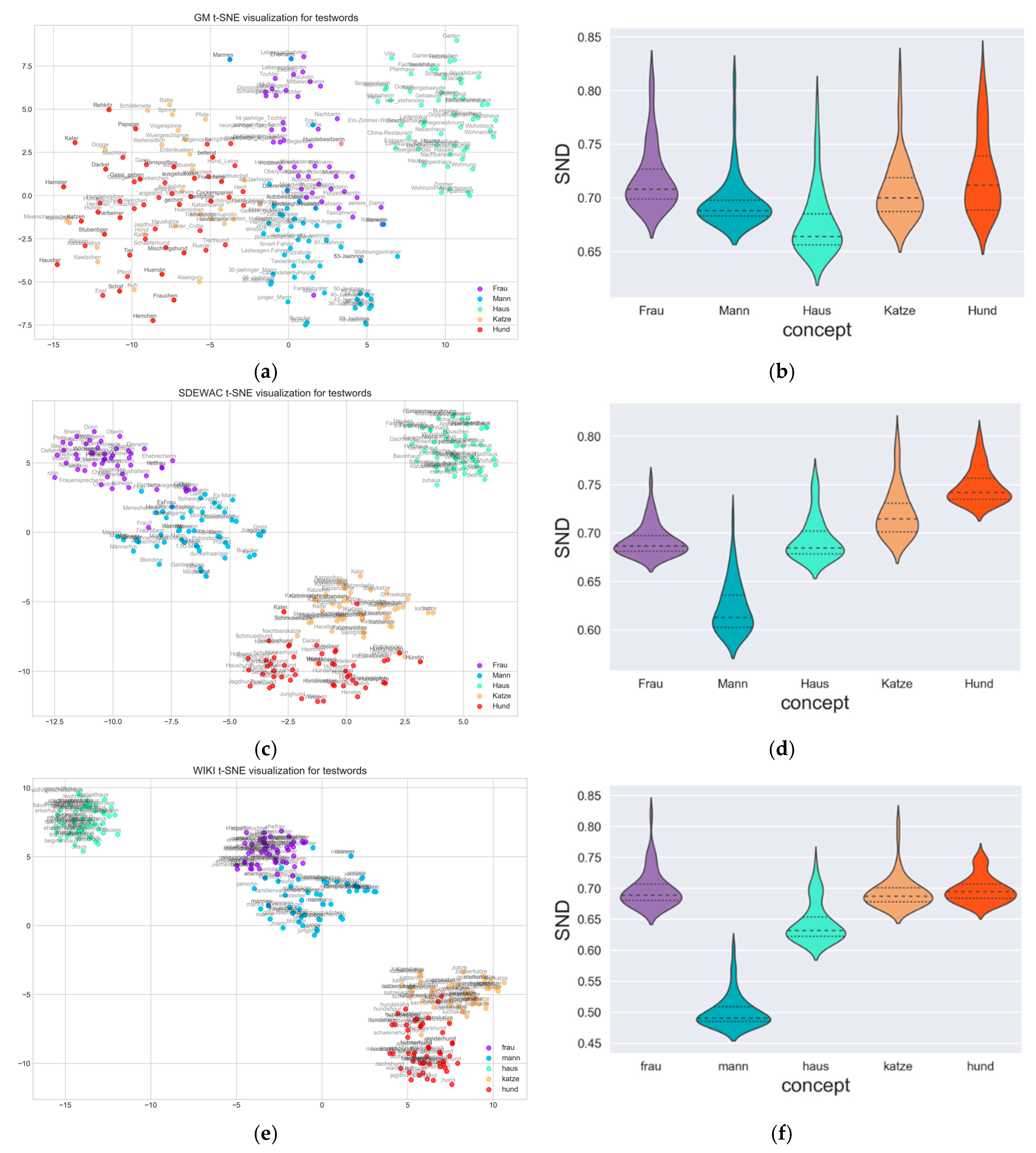
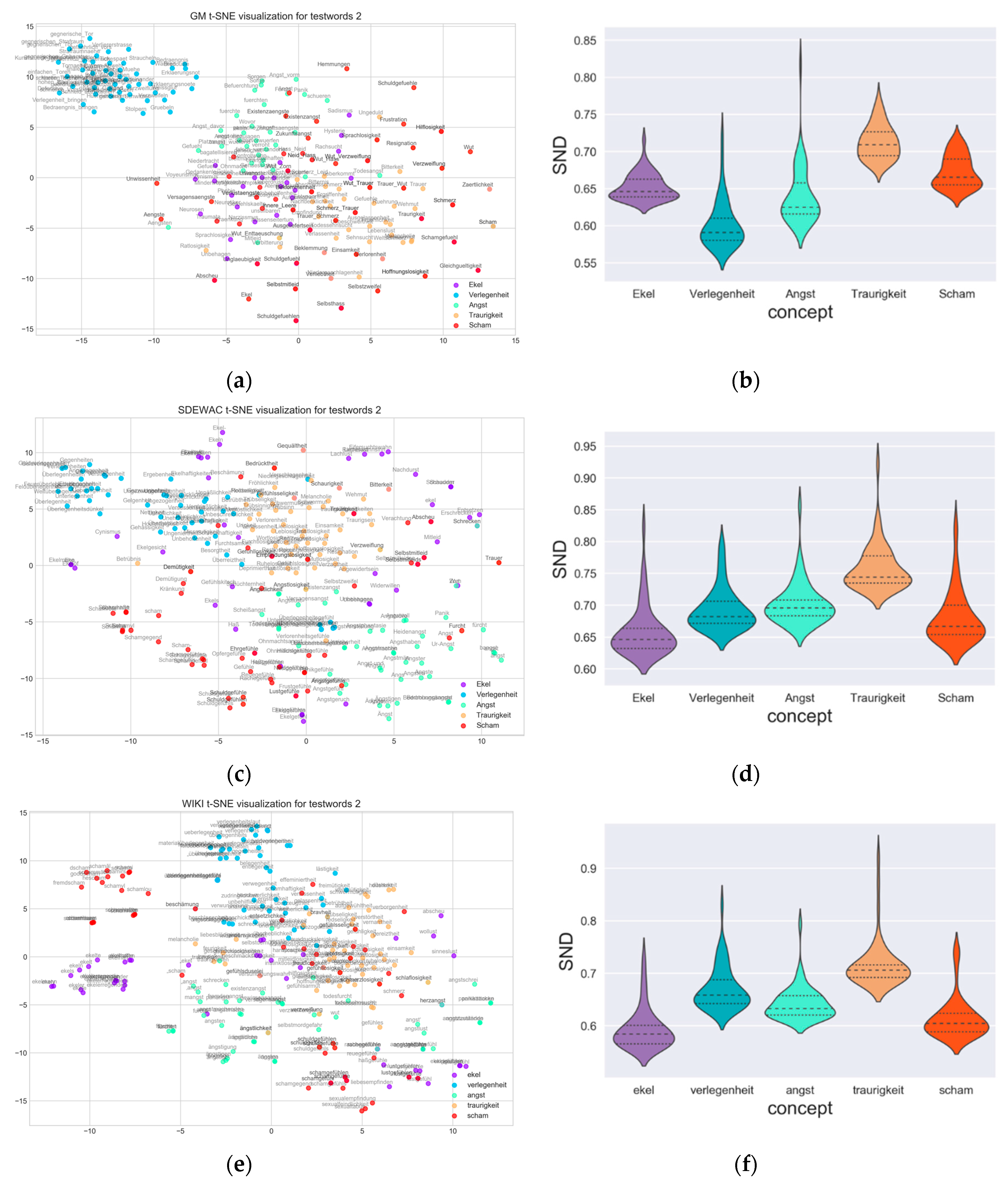
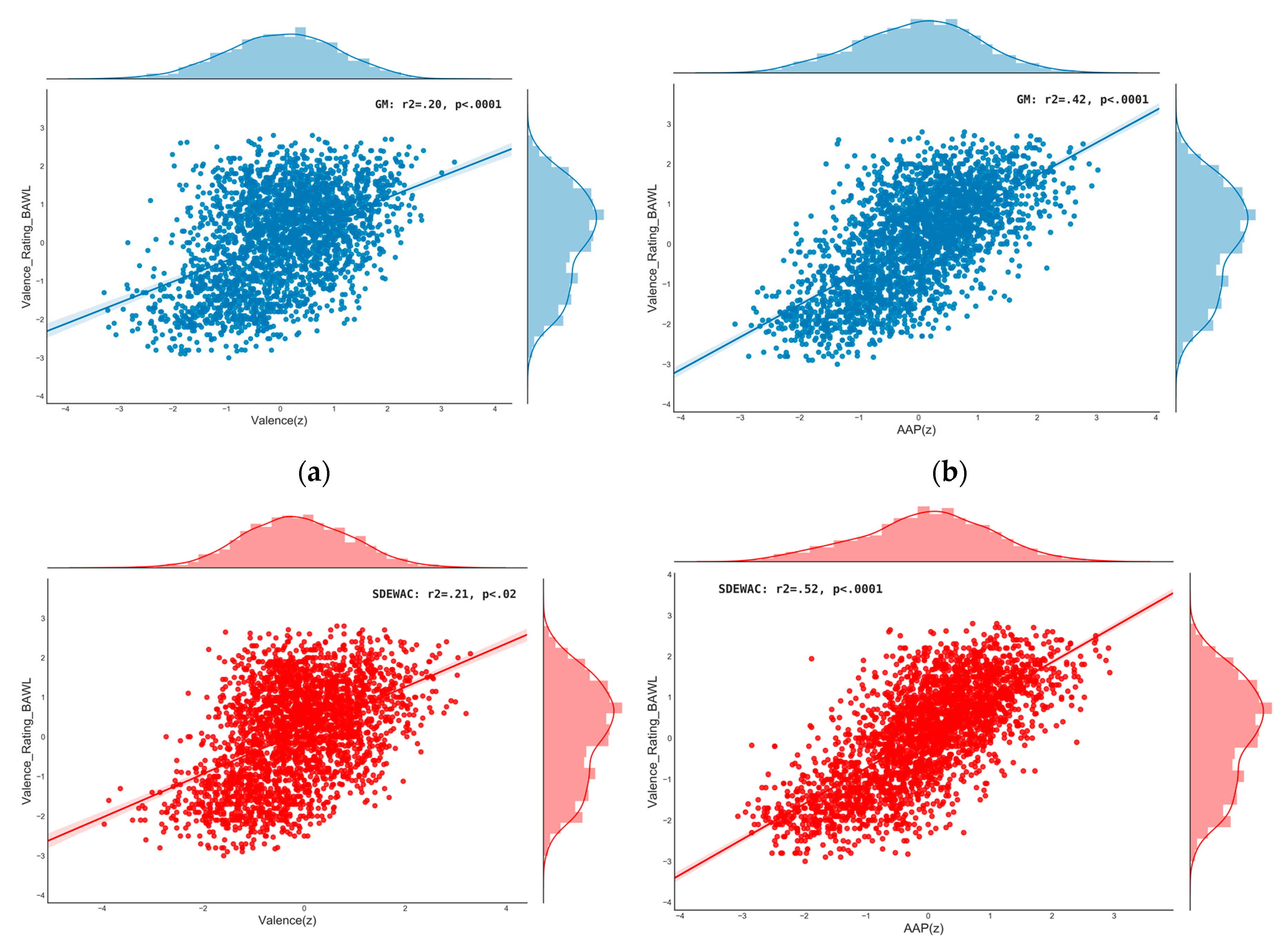
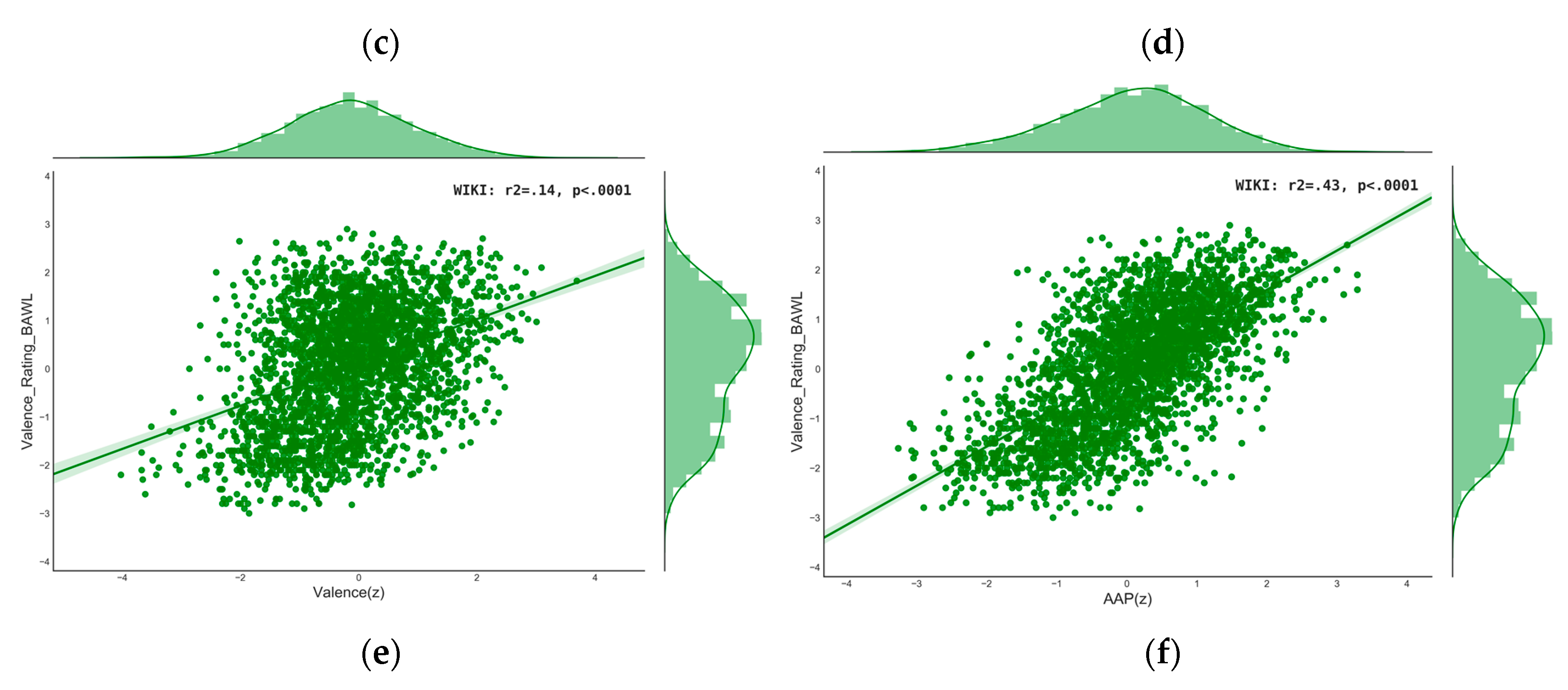
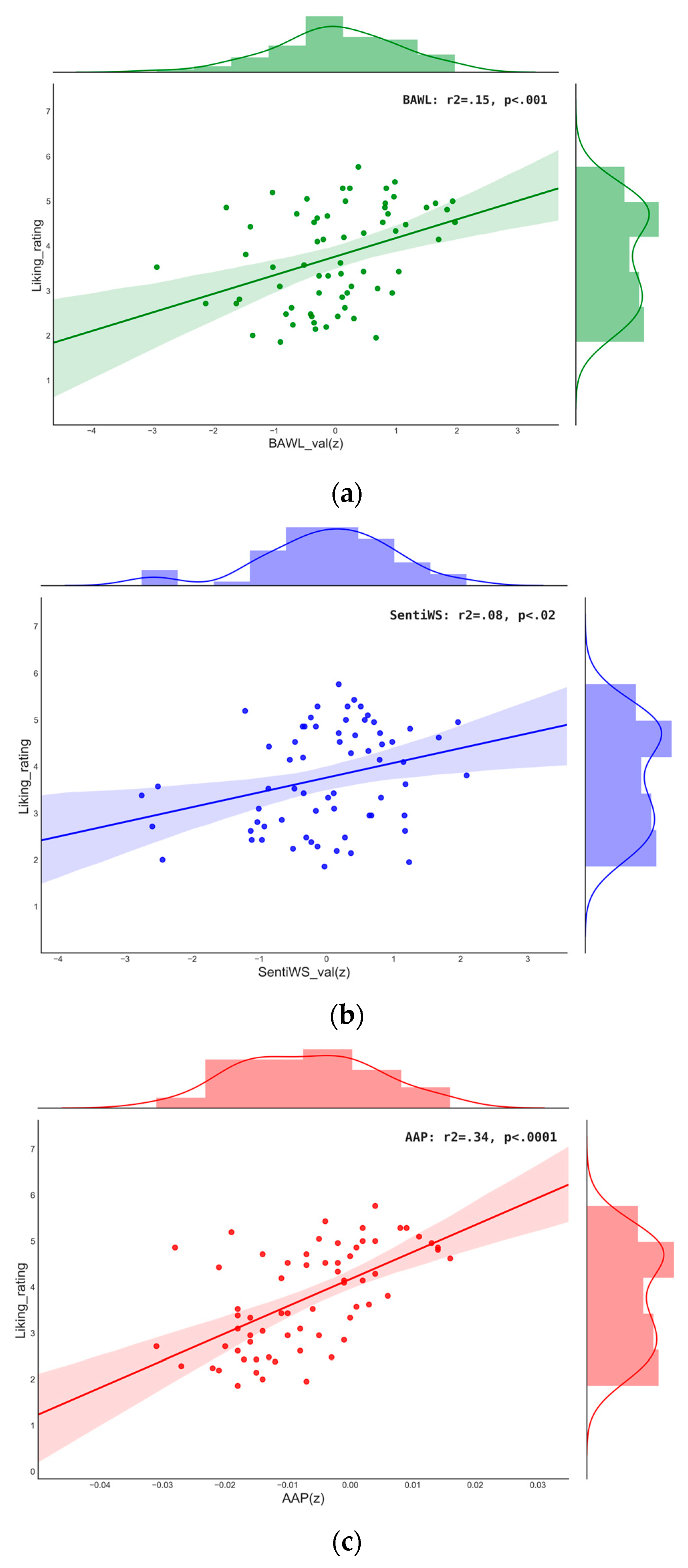
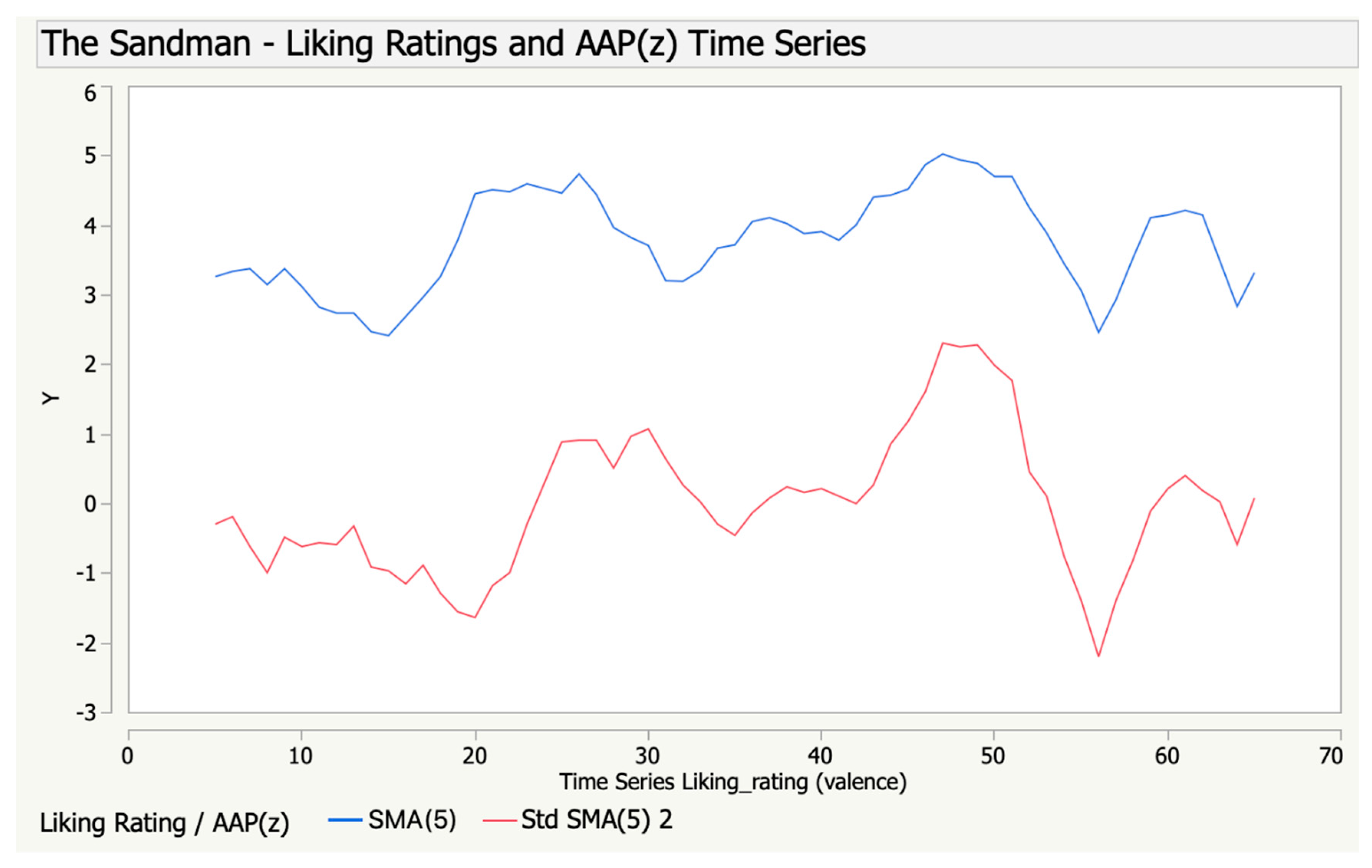
| VSM | Size (Cleaned 1), DIMENSIONALITY | Overlap with Subtlex (in Number of Unique Words) | Original Training Corpus |
|---|---|---|---|
| German.model/GM https://devmount.github.io/GermanWordEmbeddings/ | 608.130 (384.183) 300d | 86.049 | German Wikipedia and news articles (15th May 2015) |
| Sentence Dewac/SDEWAC https://www.ims.uni-stuttgart.de/en/ | 1.592.753 (1.354.303) 300d | 116.497 | unspecified German texts from the web [48] |
| Wiki.de/WIKI https://fasttext.cc/docs/en/pretrained-vectors.html | 2.275.233 (2.133.318) 300d | 114.198 | unspecified German texts from wikipedia |
© 2019 by the authors. Licensee MDPI, Basel, Switzerland. This article is an open access article distributed under the terms and conditions of the Creative Commons Attribution (CC BY) license (http://creativecommons.org/licenses/by/4.0/).
Share and Cite
Jacobs, A.M.; Kinder, A. Computing the Affective-Aesthetic Potential of Literary Texts. AI 2020, 1, 11-27. https://doi.org/10.3390/ai1010002
Jacobs AM, Kinder A. Computing the Affective-Aesthetic Potential of Literary Texts. AI. 2020; 1(1):11-27. https://doi.org/10.3390/ai1010002
Chicago/Turabian StyleJacobs, Arthur M., and Annette Kinder. 2020. "Computing the Affective-Aesthetic Potential of Literary Texts" AI 1, no. 1: 11-27. https://doi.org/10.3390/ai1010002
APA StyleJacobs, A. M., & Kinder, A. (2020). Computing the Affective-Aesthetic Potential of Literary Texts. AI, 1(1), 11-27. https://doi.org/10.3390/ai1010002




